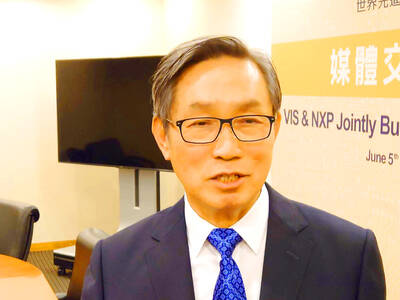Largan Precision Co (大立光), the nation's leading maker of camera lenses, posted higher-than-expected quarterly profits yesterday, thanks to surging sales in mobile-phone lenses.
The company's gross profit for the first quarter hit 61 percent, up from 42 percent during the same period a year ago.
Net income rose 356 percent to reach NT$822.25 million (US$25.31 million). Net sales expanded 189 percent to reach NT$1.62 billion for the first three months of the year, according to the company.
Meanwhile, earnings per share were NT$7.17, soaring from last year's NT$1.57.
"We expect the second quarter's momentum will be pretty much the same as the first. We certainly wish for a better second half, which is a traditionally busy period for optical-lens industry," chairman and chief executive Scott Lin (林耀英) told an investors' conference.
Growth uncertain
However, Lin was tight-lipped on projected growth, saying that factors such as yield rates, average selling prices and orders need to be taken into account.
In the first quarter, 80 percent of revenues were generated from handset lenses, while digital-camera lenses accounted for 10 percent.
The Taichung-based company said that multifunctional printer lenses and projector lenses made up 7 percent and 1 percent.
"Largan's first-quarter gross profit was slightly higher than the industry's projection," said Tom Lu (呂文輝), senior vice president of fund management department at Uni-President Asset Management Corp (統一投信).
This dynamic result was attributed to the company's product mix, which was able to ride on market trends, he added.
Though strong growth in the global handset market will continue to benefit camera-lens makers in the next few years, Largan may venture into new segments to secure long-term business sustainability, he said.
Shares of Largan were up NT$0.66 percent to close at NT$612 on the Taiwan Stock Exchange yesterday.

STEEP DECLINE: Yesterday’s drop was the third-steepest in its history, the steepest being Monday’s drop in the wake of the tariff announcement on Wednesday last week Taiwanese stocks continued their heavy sell-off yesterday, as concerns over US tariffs and unwinding of leveraged bets weighed on the market. The benchmark TAIEX plunged 1,068.19 points, or 5.79 percent, to 17,391.76, notching the biggest drop among Asian peers as it hit a 15-month low. The decline came even after the government on late Tuesday authorized the NT$500 billion (US$15.2 billion) National Stabilization Fund (國安基金) to step in to buoy the market amid investors’ worries over tariffs imposed by US President Donald Trump. Yesterday’s decline was the third-steepest in its history, trailing only the declines of 2,065.87 points on Monday and

TAKING STOCK: A Taiwanese cookware firm in Vietnam urged customers to assess inventory or place orders early so shipments can reach the US while tariffs are paused Taiwanese businesses in Vietnam are exploring alternatives after the White House imposed a 46 percent import duty on Vietnamese goods, following US President Donald Trump’s announcement of “reciprocal” tariffs on the US’ trading partners. Lo Shih-liang (羅世良), chairman of Brico Industry Co (裕茂工業), a Taiwanese company that manufactures cast iron cookware and stove components in Vietnam, said that more than 40 percent of his business was tied to the US market, describing the constant US policy shifts as an emotional roller coaster. “I work during the day and stay up all night watching the news. I’ve been following US news until 3am

Six years ago, LVMH’s billionaire CEO Bernard Arnault and US President Donald Trump cut the blue ribbon on a factory in rural Texas that would make designer handbags for Louis Vuitton, one of the world’s best-known luxury brands. However, since the high-profile opening, the factory has faced a host of problems limiting production, 11 former Louis Vuitton employees said. The site has consistently ranked among the worst-performing for Louis Vuitton globally, “significantly” underperforming other facilities, said three former Louis Vuitton workers and a senior industry source, who cited internal rankings shared with staff. The plant’s problems — which have not

TARIFF CONCERNS: The chipmaker cited global uncertainty from US tariffs and a weakening economic outlook, but said its Singapore expansion remains on track Vanguard International Semiconductor Corp (世界先進), a foundry service provider specializing in producing power management and display driver chips, yesterday withdrew its full-year revenue projection of moderate growth for this year, as escalating US tariff tensions raised uncertainty and concern about a potential economic recession. The Hsinchu-based chipmaker in February said revenues this year would grow mildly from last year based on improving supply chain inventory levels and market demand. At the time, it also anticipated gradual quarter revenue growth. However, the US’ sweeping tariff policy has upended the industry’s supply chains and weakened economic prospects for the world economy, it said. “Now